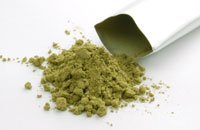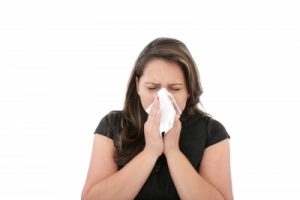After the cold winter, people are ready to enjoy spring. However, this season also comes with pollen, which is bad news if you happen to be allergic to it.
I’m also one of those people, so I take antihistamines in order to feel better. But what if the solution could be as simple as drinking a specific type of tea?
How Allergies Work
Basically, an allergy is an autoimmune response. Although the substance itself may be harmless, such as pollen or animal dander, it’s considered an invader by the allergic person’s body.
When encountering an allergen (substance that generates the allergic response), antibodies specially engineered to fight that allergen are produced. There are different types of antibodies, but the one responsible for allergic reactions is IgE.
IgE antibodies become attached to mast cells, and when there is a second exposure to the allergen, the antibodies identify it and trigger the mast cells into releasing a number of chemicals, one of them being histamine.
Ultimately, high quantities of histamine result in allergy symptoms such as watery eyes, sneezing and runny nose.
Methylated catechins in tea
O-methylated catechins, epigallocatechin-3-O-(3-O-methyl) gallate ( shortened to EGCG”Me) and epicatechin-3-O-(3-O-methyl) gallate ( shortened to ECG3″Me), commonly known as methylated catechins, have been shown to relieve allergy symptoms.
They do so by inhibiting the mast cell response. The recommended dose is 34 mg of methylated catechins in tea per day, and about a month and a half before the pollen season.
However, only specific cultivars have a significant content of this type of catechins: Benihomare, Benifuji, and Benifuuki (which has the highest). Yabukita, the most popular tea cultivar in Japan, doesn’t have any.
Although these cultivars where developed for black tea production, the methylated catechin content is destroyed in the black tea process. Thus, for the anti-allergic effect you need to drink it in green tea form.
The highest concentration is found in mature leaves under the fourth shoot of the first crop, and under the third shoot of the second crop. The stems have a very low amount of methylated catechins, so they should be filtered. The resulting tea is also naturally low in caffeine.
 It’s usual in Japan to drink this tea in powdered form. For the recommended dose, dissolve 1.5 grams of the powdered tea with 200 ml (6.6 oz) of hot water. Drink twice per day.
It’s usual in Japan to drink this tea in powdered form. For the recommended dose, dissolve 1.5 grams of the powdered tea with 200 ml (6.6 oz) of hot water. Drink twice per day.
Sources:
O-Methylated Catechins from Tea Leaves Inhibit Multiple Protein Kinases in Mast Cells






April 1, 2014
Since Benifuuki has elements of Assamica in it, I wonder if the Assam varieties in South Asia also have high (higher) concentrations of O-methylated catechins if they are made into green teas instead of red teas. That should be an interesting study.
April 6, 2014
Benihomare is of the Assamica variety, so I think that methylated catechins are present in South Asian cultivars too.
I agree that this should definitely be studied.
April 8, 2014
Good subject to cover this time of year. There’s a great review article that covers a study showing that drinking teas rich in O-methylated catechin from 6 weeks before allergy season AND through allergy season has the best effects. I’m not sure how easy the article would be to find, but here is the reference: Maeda-Yamamoto, Mari. 2013. Human clinical studies of tea polyphenols in allergy or life style-related diseases. Current Pharmaceutical Design, 19, 6148-6155. You can read the abstract here: http://www.ingentaconnect.com/content/ben/cpd/2013/00000019/00000034/art00009
April 8, 2014
Hello Noli
Thanks for the link. Maeda-Yamamoto is probably the leader regarding this topic, because I saw her name in many studies.
April 8, 2014
Ricardo,
I recommend reading that article because it has so much great information on not just allergies, but all different types of health benefits of green tea, and it also compares green tea to oolong and black tea in some cases. Since it is a review article, you may want to hunt down some of the original articles for more information.
May 10, 2015
Thanks for the article. I am also trying the tea, but it’s very difficult to find in Europe, and must be ordered online from Japan (very expensive, about 20€ per 30g).
I was wondering, given the dose used in the study (34mg of catechins daily in 700ml water), what does it means in terms of powdered tea?
I see you recommend 1.5 grams to 200 ml water.
Do we know how many mg catehins does 1g of powdered benifuuki tea contains?
May 10, 2015
Hello Stefano, thank you for your comment.
You made me realize that I had forgotten to add another dose! It would be twice a day, I just corrected it.
The estimate is 1.5% of milligrams of methylated catechins per gram of benifuuki powder, so that in 1 gram of benifuuki powder you’ll get 15 mg of methylated catechins.
Hence, when you drink 1.5 grams twice you already get 45 mg.
You can also try more grams in one serving, but it becomes very bitter.
April 11, 2021
hi
can green tea extract not work for allergy?
can benifuki strong inhabit mast celles in the first day in use?
can egcg in it or all including acids
April 11, 2021
Green tea extract by itself does not work for allergy unless it has methylated catechins in it. Most green tea extracts don’t have methylated catechins.
The effect is stronger after a month of use.
April 11, 2021
why become stronger after one month so what can do in mast celles ?
this mean not work slightly in the first day?
how many cup from powder to completly inhabit mast celles in one day?
April 12, 2021
Hi Mohamed
That is what the studies say.
Please read the post, the recommended dose is 3 grams of the powder per day.